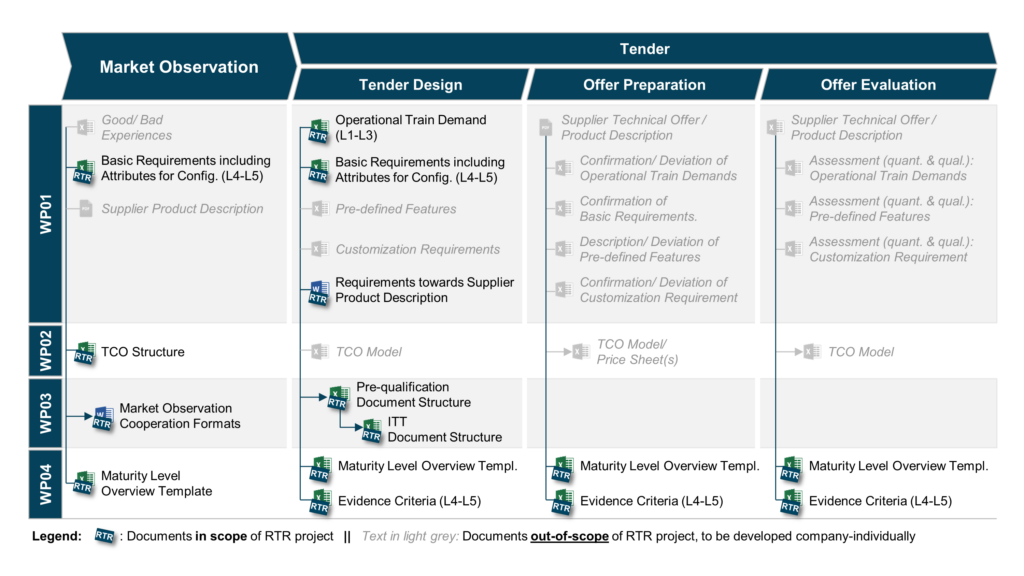
Overview of Results & Framework
Overall Framework to improve the overall competitiveness of the railway sector
To jointly contribute to the improvement and enhancement of overall competitiveness of the railway sector, the Round Table Rolling Stock (RTR) Initiative has the target to improve the way of working between railway operators and rolling stock suppliers in the procurement of rolling stock and to significantly reduce development efforts.
The Initiative – being open to all interested stakeholders and consisting of representatives from both market sides (i.e., suppliers and operators) – decided to work jointly on the development of five specific topics or respectively work packages:
- WP01 – Specification Catalogue
Define a common requirements structure and set of commonly applied and generally agreed basic voluntary requirements that should enable the industry to move towards a “product-oriented” business approach! - WP02 – Total Cost of Ownership Structure
Define a conceptual design for a common structure of generic cost items that may drive total cost of ownership for a rolling stock fleet (without any quantification). - WP03 – Product Development & Procurement Process
Create a common understanding of the rolling stock product development and procurement process and define concepts for enhanced industrial cooperation between operators and suppliers in the market. - WP04 – Maturity Model
Define a common maturity model for technical (sub-)systems of vehicles which can be applied operationally to identify and communicate risks during the procurement process of rolling stock. - WP05 – Sustainability
Creating voluntary generic CO2 footprint framework and measurement tools for rolling stock, starting with a review of current existing norms, standards and rolling stock specific approaches and leading into assessments of legal and economic feasibility, to improve the industry’s approach to sustainability.
Overview of selected results
The development of an overall target process may enable the realization of existing optimization potentials by applying developed RTR results along the process (further information can be found here: WP03 – Product Development & Procurement Process).
By combining all developed results of each work package and the target product development and procurement process, an associated overview about the explicit application of these results along the process can be derived. In the Figure illustrated below, an exemplary application is illustrated and briefly explained along the market observation and tender phase. The distinctive application of the RTR results within the project execution phase is not described at this point, since the majority of results can already be explained based on previous processes.
The railway operations process solely focuses on sharing feedback and experiences between operator and supplier, while company individual operational processes and activities have not been elaborated on. By gaining feedback the loop towards the market observation is closed, leading to a reoccurring and continuous bilateral dialogue between operator and supplier:

Market Observation
In addition to the generated feedback during operations, operators share with suppliers (and vice-versa) good and bad experiences (e.g., bilateral operator-supplier product dialogues) on a regular basis. Furthermore, the latest version of RTR basic requirements catalogue is continuously available within the industry. To allow operators having a comprehensive overview about the offered products and platforms and to compare their maturity, in the procurement process suppliers can state current technical and integration readiness levels within the Maturity Level Overview Template. In parallel a supplier may apply a TCO Model based on the RTR TCO Structure to concretize its discussions with the operator along different cost items (and vice-versa).
Tender Design
The tender process is triggered by an operator describing its demand within an operational train demand (level 01-03) template, while again all basic requirements (level 04/05) are available. Furthermore, the operator chooses and attaches attributes for configuration and defines, if necessary, individual customization requirements. Besides that, the operator may attach additional requirements and the structure towards the technical offer and may design the evaluation and award criteria, potentially including a detailed TCO model (e.g., weightings, parameters, etc.) within the context of the standardized ITT document structure.
Offer Preparation
Within the offer preparation the supplier chooses the best suitable platform based on its product description, to fulfill requirements of the operator. Subsequently, the supplier designs a detailed technical offer and confirms the fulfillment of operational train demand (level 01-03) as well as basic requirements (level 04/05). All maturity levels on train(set) system and (sub-)system level is listed via standardized RTR Maturity Model Overview Template and are submitted together with all other relevant offer documents. Finally, the supplier provides information on costs in line with a TCO Model and respective price sheets and separates prices for options and individual customization requirements to the operator.
Offer Evaluation
To evaluate submitted offers by suppliers, the operator assesses the fulfilment of operational train demand (level 01-03), basic requirements (level 04/05), attributes for configuration as well as customization requirements. Furthermore, maturity levels on train(set) system and (sub-)system level as well as TCO information in line with awarding criteria are considered. In the end, the operator prepares, conducts, and communicates the awarding decision.
Download Results
To get full access to the download section, incl. all developed results, please register here.
After access has been granted, you will get access to the following documents (see attached presentation)











